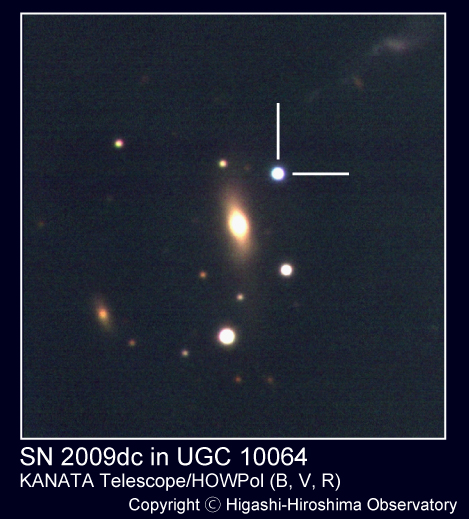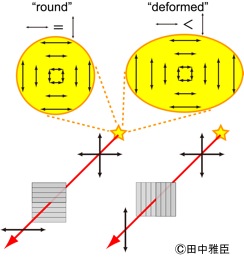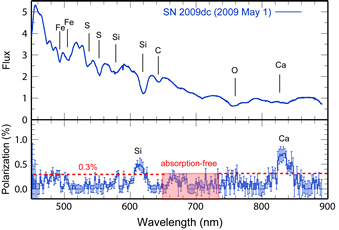Kashiwa, Japan — A group led by Masaomi Tanaka (Institute for the Physics and Mathematics of the Universe, IPMU), Masayuki Yamanaka, Koji Kawabata (Hiroshima University), Ken’ichi Nomoto, and Keiichi Maeda (IPMU) revealed the nature of the most luminous Type Ia supernova (SN) by the intensive observations with Subaru Telescope and domestic telescopes.
Type Ia SNe are the explosion of a white dwarf. The explosion is triggered when the mass of the white dwarf become close enough to the Chandrasekhar’s limit (~1.4 solar mass ). The research group has observed a SN discovered in 2009 April, SN 2009dc, with Subaru Telescope and several domestic telescopes. The group has revealed that SN 2009dc is the most luminous Type Ia SN, and its mass exceeds 1.4 solar mass. The progenitor star of SN 2009dc is thought to be rapidly rotating so that it can support the large mass.
It has been believed that Type Ia SNe have a constant mass and nearly constant luminosity. Thanks to these properties, Type Ia SNe have been used as a distance indicator in the universe. The newly discovered, “super-Chandrasekhar” mass Type Ia SN casts questions on the current theoretical scenario of Type Ia SNe and their use in cosmology.
The group consists of researches mainly in University of Tokyo, Hiroshima University, National Astronomical Observatory of Japan, Gunma Astronomical Observatory, Kagoshima University, Tokyo Institute of Technology, Max Planck institute for Astrophysics, Scuola Normale Superiore di Pisa (listed below). These results were presented in the annual meeting of the Astronomical Society of Japan, held at Yamaguchi University on 2009 September 14-16.
Fig. 1
Optical image of the most luminous Type Ia SN 2009dc in UGC 10064, taken with the KANATA telescope, Higashi-Hiroshima observatory, Hiroshima University (observed by a group led by Masayuki Yamanaka). The SN is marked with the two lines. The image size is 3 arcmin x 3 arcmin.
 Optical image of the most luminous Type Ia SN 2009dc in UGC 10064
Optical image of the most luminous Type Ia SN 2009dc in UGC 10064
Fig. 2
Two other extremely luminous Type Ia SNe, SNe 2003fg and 2006gz, have been already discovered before (they are less luminous than SN 2009dc). However, there is a scenario that these extremely luminous SNe are caused by a highly asymmetric explosion of a Chandrasekhar-mass white dwarf. Unfortunately, we cannot “see” the shape of the SN explosion because SNe are discovered in distant galaxies (about a few million light years away).
Thus, a group led by Masaomi Tanaka performed the polarization measurement of the SN. If the explosion is not round, we would detect a variation in the strength of the light, depending on the oscillating direction of electromagnetic wave (“deformed” case in the figure). This is the first polarization measurement for the candidate of “super-Chandrasekhar” mass SN.

Fig. 3
The group performed polarization measurement of SN 2009dc with Subaru Telescope equipped with FOCAS. The figure shows the flux spectrum (top panel) and the polarization spectrum of SN 2009dc (bottom). Since absorption features by the element alter the polarization status, the region marked in red shade can be used as an indicator of the explosion shape. With accurate measurements, the polarization is found to be only < 0.3%. Therefore, the extremely luminous Type Ia SN 2009dc is almost round, and thus, it is concluded that the progenitor has a “super-Chandrasekhar” mass.
 the flux spectrum (top panel) and the polarization spectrum of SN 2009dc (bottom)
the flux spectrum (top panel) and the polarization spectrum of SN 2009dc (bottom)
Research Group (alphabetical order)
Aoki, K., Arai, A., Chiyonobu, S., Fukazawa, Y., Hashimoto, O., Hattori, T., Honda, S., Ikejiri, Y., Imada, A., Itoh, R., Iye, M., Kamata, Y., Kawabata, K.S., Kawai, N., Kinugasa, K., Komatsu, T., Kuroda, D., Maeda, K., Mazzali, P. A., Miyamoto, H., Miyazaki, S., Nagae, O., Nakaya, H., Nomoto, K., Ohsugi, T., Omodaka, T., Pian, E., Sakai, N., Sasada, M., Sasaki, T., Suzuki, M., Taguchi, H., Takahashi, H., Tanaka, H., Tanaka, M., Uemura, M., Yamanaka, M., Yamashita, T., Yanagisawa, K., Yoshida, M.
Contacts
Science Contacts
- Ken’ichi Nomoto
- Professor
- Institute for the Physics and Mathematics of the Universe
- E-mail: nomoto@astron.s.u-tokyo.ac.jp
Media Contact
- Fusae Miyazoe
- Press Officer
- Institute for the Physics and Mathematics of the Universe
- E-mail: press@ipmu.jp






